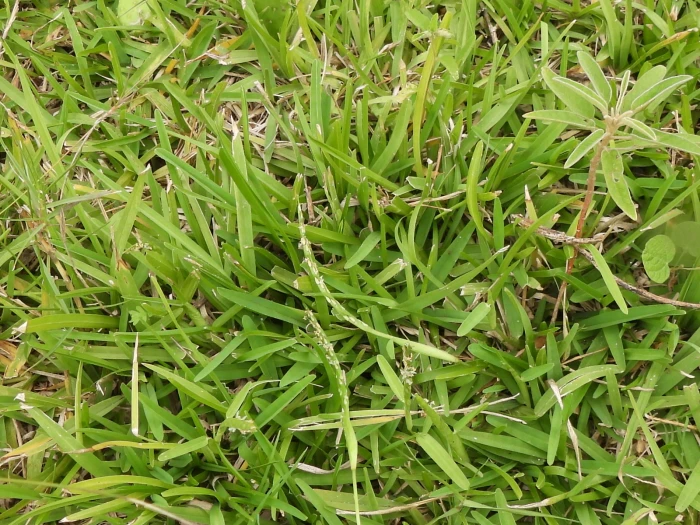St. Augustine Grass
(Stenotaphrum secundatum)
St. Augustine Grass (Stenotaphrum secundatum)
/
/

Sam Kieschnick
CC BY 4.0
Image By:
Sam Kieschnick
Recorded By:
Copyright:
CC BY 4.0
Copyright Notice:
Photo by: Sam Kieschnick | License Type: CC BY 4.0 | License URL: http://creativecommons.org/licenses/by/4.0/ | Rights Holder: Sam Kieschnick | Publisher: iNaturalist | Date Created: 2023-05-20T11:49:53-07:00 |
















































Estimated Native Range
Climate Requirements for Walnut Creek, California
| This Plant | Your Site | Plant Suitability for Your Location | ||
|---|---|---|---|---|
| • Precipitation | Unknown" - 173" | 19" | Your precipitation may be insufficient for this plant. Irrigate N" / year. | Irrigate N" / year |
| • High Temp. | 57°F - 108°F | 86°F | Your summer temperatures are normal for this plant. | Excellent |
| • Low Temp. | -4°F - 75°F | 39°F | Your winter temperatures are normal for this plant | Excellent |
This plant should grow well at your location with about N inches per year (Y minutes per month) of irrigation.
Summary
Stenotaphrum secundatum, commonly known as St. Augustine grass or buffalo turf, is a warm-season perennial grass that thrives in tropical and subtropical climates. It is native to coastal regions, salt marshes, and sandy beach ridges in the Gulf of Mexico, the Caribbean, South America and West Africa. This grass typically forms a thick, carpet-like sod that can tolerate a wide range of soil types, with an optimal pH between 5.0 and 8.5. St. Augustine grass spreads by stolons, which are horizontal above-ground stems that root at the nodes, creating a dense and robust layer of turf.
St. Augustine grass is valued for its ability to establish quickly and form a dense ground cover, making it a popular choice for lawns, golf courses, and public areas in warm climates. It is particularly appreciated for its shade tolerance compared to other warm-season grasses. However, it requires consistent moisture and does not tolerate drought well. It performs best in full sun to partial shade and needs regular mowing to maintain an even height. While it can be susceptible to chinch bugs, gray leaf spot, and fungal diseases, proper lawn care practices can mitigate these issues. Due to its aggressive growth, it can become invasive outside its native range, so it is essential to consult local guidelines before planting.CC BY-SA 4.0
St. Augustine grass is valued for its ability to establish quickly and form a dense ground cover, making it a popular choice for lawns, golf courses, and public areas in warm climates. It is particularly appreciated for its shade tolerance compared to other warm-season grasses. However, it requires consistent moisture and does not tolerate drought well. It performs best in full sun to partial shade and needs regular mowing to maintain an even height. While it can be susceptible to chinch bugs, gray leaf spot, and fungal diseases, proper lawn care practices can mitigate these issues. Due to its aggressive growth, it can become invasive outside its native range, so it is essential to consult local guidelines before planting.CC BY-SA 4.0
Plant Description
- Plant Type: Grass
- Height: 0.1-0.3 feet
- Width: 1-2 feet
- Growth Rate: Rapid, Moderate
- Flower Color: N/A
- Flowering Season: Spring, Summer, Fall
- Leaf Retention: Evergreen
Growth Requirements
- Sun: Full Sun, Part Shade
- Water: High
- Drainage: Medium
Common Uses
Erosion Control, Groundcover
Natural Habitat
Native to coastal regions, salt marshes, and sandy beach ridges in the Gulf of Mexico, the Caribbean, and West Africa
Other Names
Common Names: Charleston Grass , Buffalo Grass , Grama-De-Jardim , Grama-Inglesa , Grama-Italiana , Pimento Grass
Scientific Names: Stenotaphrum secundatum , Diastemanthe platystachys , Ischaemum secundatum , Rottboellia dimidiata , Rottboellia paleacea , Rottboellia paleacea , Rottboellia stolonifera , Rottboellia tripsacoides , Stenotaphrum americanum , Stenotaphrum dimidiatum subsp. americanum
GBIF Accepted Name: Stenotaphrum secundatum